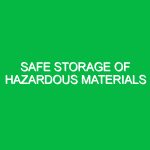Chemical labeling standards are essential protocols that govern how hazardous substances are identified and communicated to ensure safety in various environments, particularly in workplace settings. These standards are not merely bureaucratic mandates; they are vital components of health, safety, and environmental (HSE) practices. By providing clear and concise information about the hazards associated with chemicals, these labels help prevent accidents, injuries, and environmental damage. In this article, we will delve into the intricacies of chemical labeling standards, explore potential hazards associated with chemical labels, discuss safety precautions, and highlight pertinent regulations that govern these practices.
Understanding Chemical Labeling Standards
Chemical labeling standards are frameworks established to ensure that information regarding hazardous chemicals is conveyed effectively. These labels serve multiple purposes: they inform users of the chemical’s identity, its hazards, and the necessary precautions to take. The Globally Harmonized System of Classification and Labelling of Chemicals (GHS) is one of the most recognized international standards in this area. It was developed by the United Nations to standardize chemical classification and labeling across countries, making it easier for businesses and employees to understand the risks associated with various substances.
For example, a well-designed label might include pictograms that visually represent the hazards, signal words that indicate the severity of the risk, and specific precautionary statements about safe handling and storage. This multifaceted approach ensures that even those with limited knowledge of chemistry can comprehend the dangers and necessary safety measures associated with a chemical.
The Importance of Chemical Labeling Standards in HSE
In the HSE domain, effective chemical labeling is not just a regulatory requirement; it’s a cornerstone of workplace safety. Poorly labeled chemicals can lead to mishandling, spills, and accidents. In a real-life scenario, a factory worker in Michigan once mistakenly mixed two chemicals because their labels were unclear, resulting in a violent reaction that caused significant injuries and property damage. This incident underscores the critical need for clear and accurate labeling.
Moreover, chemical labeling standards play a crucial role in emergency response. In the event of a spill or exposure, first responders rely heavily on chemical labels to quickly assess the situation and make informed decisions. Therefore, the implications of effective labeling extend beyond just compliance; they can save lives and protect the environment.
Identifying Hazards and Risks Associated with Chemical Labeling
Understanding the hazards associated with chemical labeling is essential for mitigating risks in the workplace. The potential hazards can be broadly categorized into physical hazards, health hazards, and environmental hazards.
Physical Hazards
Physical hazards include risks associated with the chemical’s physical properties, such as flammability, reactivity, and corrosiveness. For instance, a flammable liquid, when improperly labeled, can lead to catastrophic fires. An example of this occurred in a laboratory setting when a researcher inadvertently used a flammable solvent without realizing its combustibility due to inadequate labeling. The resulting fire caused extensive damage and injuries.
Health Hazards
Health hazards pertain to the potential for acute or chronic health effects due to exposure to chemicals. This can include respiratory issues, skin irritations, or long-term illnesses like cancer. Accurate labeling is crucial here; for instance, if a chemical is labeled as “non-toxic” when it contains hazardous components, workers may be exposed to serious health risks without realizing it.
Environmental Hazards
Environmental hazards refer to the potential harm chemicals can inflict on ecosystems. For instance, chemicals that can contaminate water sources or degrade soil quality must be clearly labeled to prevent improper disposal or spills. A case in point is when a company improperly disposed of labeled hazardous waste, leading to significant environmental contamination and hefty fines.
Best Practices and Safety Precautions for Chemical Labeling
To ensure that chemical labeling standards are met and that safety is prioritized, several best practices can be implemented.
1. Use Clear and Standardized Language
Labels should utilize clear, concise language that adheres to established guidelines. Avoid jargon that may confuse users. For instance, instead of saying “may cause irritation,” a label could state “causes skin irritation.” This clarity ensures that everyone understands the risks involved.
2. Incorporate Pictograms and Signal Words
Pictograms are a powerful tool for conveying hazards quickly. The GHS provides standardized symbols that can be universally recognized, helping workers and emergency responders identify risks at a glance. Signal words like “Danger” or “Warning” should be prominently displayed to indicate the severity of the hazards.
3. Regularly Update Labels
Chemical formulations can change, and new safety information may arise. Regularly updating labels ensures that they reflect the most current information. For example, if a new study reveals a previously unknown health risk associated with a chemical, the label must be updated immediately to inform users.
4. Training and Education
Employers should provide training on how to read and interpret chemical labels effectively. This training should be an ongoing process, especially for new employees. A well-informed workforce is a key element of workplace safety.
5. Conduct Regular Audits
Regular audits of chemical storage areas and labeling practices can identify compliance issues before they lead to accidents. These audits should assess whether labels are legible, accurate, and compliant with relevant standards.
Regulations and Standards Governing Chemical Labeling
Several regulations govern chemical labeling, each contributing to a safer working environment. Key among them is the Occupational Safety and Health Administration (OSHA) Hazard Communication Standard (HCS) in the United States, which aligns closely with the GHS. This regulation requires employers to inform and train employees about the hazardous chemicals they may encounter on the job.
Internationally, the GHS provides a framework for consistent labeling, but individual countries may have their own specific regulations. For example, the European Union has the Classification, Labelling and Packaging (CLP) Regulation, which aligns with the GHS but includes additional requirements specific to EU member states. Companies operating in such jurisdictions must ensure compliance with both local and international standards.
Conclusion
Chemical labeling standards are a critical aspect of health, safety, and environmental protection. By providing clear, standardized information about the hazards of chemicals, these labels play a vital role in preventing accidents and ensuring the safety of workers and the environment alike. Understanding the potential hazards, adhering to best practices, and complying with regulations are essential steps in fostering a culture of safety. As organizations continue to navigate the complexities of chemical management, prioritizing robust labeling practices will undoubtedly lead to safer workplaces and a healthier environment for all.


